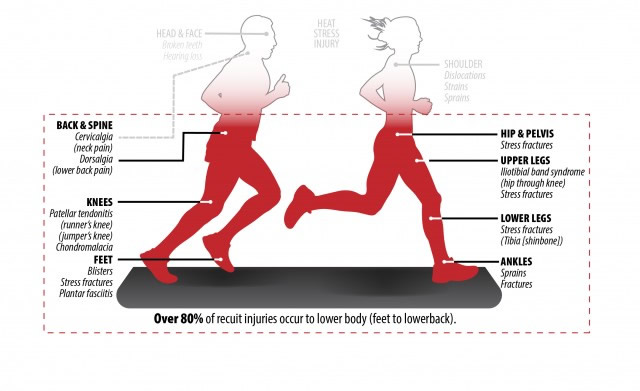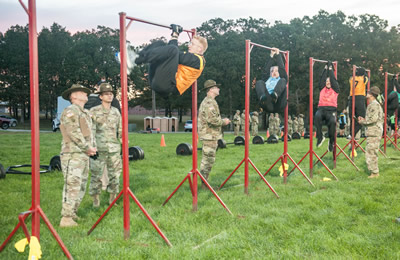ABERDEEN PROVING GROUND, MD—How can the Army maintain fitness, promote combat-readiness and minimize injuries? The Army Public Health Center at the Aberdeen Proving Ground in Maryland has been investigating options and sharing ideas for three decades, with mixed results.
“It is a paradox that the very physical training activities required or encouraged by the U.S. Army to improve soldiers’ physical performance, are also what can most detract from their physical readiness by causing injuries,” noted APHC researchers in an article on musculoskeletal training injury prevention.1
Training properly essentially employs the Goldilocks principle: Not too much and not too little. The challenge is that the “just right” level varies by individual. Clear thresholds above which injuries increase while fitness plateaus or declines have not been established, noted Bruce Jones, MD, MPH, senior scientist at APHC. For the individual, current level of fitness, previous injuries, body mass and age all factor in.

Focus on Aerobic Fitness
Perhaps most important is aerobic fitness. “Recent data show that soldiers who have slow two-mile run times (i.e., men who take more than 15 minutes and women who take more than 19 minutes) have a higher risk of injury. Even soldiers who ‘look’ fit and are within body fat standards have a higher injury risk if they run slow,” according to Sarah Dobson and Veronique Hauschild, MPH, of the APHC.
For these soldiers, however, the seemingly logical strategy of just running more actually leads to worse results, the Army has found. “We can show that greater amounts of training (for example, of running or road marching) result in more injuries,” said Michelle Chervak, PhD, MPH, acting manager for the APHC Injury Prevention Program. In part, that’s because slow runners take more steps, increasing the stress on their joints.
Instead of telling slower soldiers to “hit the road” to get up to speed, the APHC recommends referring them to one of the Army’s 35 Wellness Centers. The centers help soldiers develop individualized plans to increase their overall fitness—and reduce their risk of musculoskeletal injuries associated with overuse.
A key component of the plans is high-intensity interval training, which maximizes cardio fitness without increasing time and stress on the vulnerable lower body and back, though other kinds of training also improve aerobic fitness with less risk than running.
Reduced Injuries
The movement away from running to improve fitness in at-risk soldiers continues a trend begun more than 15 years ago when an Army study found that a group employing a physical training program designed to minimize overuse injuries during nine weeks of basic combat training performed better on the Army Physical Fitness Test than a group that trained using traditional methods, including running, calisthenics, pushups and situps.
The Army adopted the new physical training program for basic training in 2004, which reduced the amount of running required, divided units into ability groups for longer runs, increased training time and intensity more gradually and incorporated a wider range of exercises. According to the APHC, the changes resulted in a 46% decline in all injuries and 54% drop in musculoskeletal overuse injuries among recruits over the next decade.
Still, not all commanders or soldiers have gotten the message that more isn’t necessarily better and continue to focus on frequent, long runs.
“High or increasing injury rates should be a wake-up call to leaders, indicating a need to adjust the physical training program to prevent over-training. This will reduce injuries and ultimately enhance fitness and physical performance,” Jones said.
Likewise, soldiers should be educated on the risk of “pushing through the pain.” Highly competitive or motivated service members may suffer more serious injury by ignoring signals from their bodies to stop an activity.
According to Hauschild, a strong training program that minimizes injuries:
- Avoids excessive running by mixing low-impact aerobic activities such as swimming or biking with running and slowly increasing the distance and time spent running. Running or running followed by a ruck march should be avoided on consecutive days. Injured servicemembers should not run, and group runs should cluster runners by speed and endurance.
- Includes a variety of exercises that focus on aerobic fitness, strength, agility and conditioning.
- Encourage semirigid ankle braces and mouth guards during basketball and training for parachuting and combatives.
- Slowly increase weight and focus on form in weight-lifting and other conditioning programs.
Fitness Test
The Army introduced the six-component Army Combat Fitness Test in October, which will replace the Army Physical Fitness Test in October 2020. The new test is designed to better evaluate combat readiness and promote more balanced training.
 It has another purpose as well. “The new fitness test is a response to high rate of injuries,” said Marvin Helgeson, MD, chief of orthopedics at Walter Reed National Military Medical Center in Bethesda, MD.
It has another purpose as well. “The new fitness test is a response to high rate of injuries,” said Marvin Helgeson, MD, chief of orthopedics at Walter Reed National Military Medical Center in Bethesda, MD.
Despite studies that demonstrate that the Physical Readiness Training program rolled out in 2012 reduces injuries compared to running-centered training programs, many units continue with the old training methods and continue to rack up high rates of injury. Changing the way fitness is officially measured may stimulate broader adoption of the PRT to better prepare for a more comprehensive physical assessment, Hauschild said.
The ACFT keeps the 2-mile run but drops the situp and modifies the pushup component. It adds a standing power throw, sprint drag and carry and leg tuck hold.
In addition, “the new fitness test has a deadlift on it. That’s a unique activity,” Helgeson told U.S. Medicine, and one that could prove problematic. “Lifting weight increases intradiscal pressure and we don’t know if that will increase back injuries. It matters how people train for it, too,” he noted.
The test limits the weights to 340 pounds, but gradual increase in weight is recommended to minimize the risk of disc herniation and knee injuries. The APHC recommends against use of a back brace, as they can increase the risk of injury, and advises that training by bench-pressing heavy weights has a greater risk of rupturing muscles or tendons than other options.
The APHC’s list on potential injury concerns associated with the new test suggests that lower body injuries could be exchanged for upper body issues and more back and spine injuries. In addition to the inherent challenges of the deadlift, the standing power throw and hand-release pushup also could cause back, neck or shoulder injury. The sprint-drag-carry raises concerns about damage to the knees, shoulders, elbows and back, and the leg tuck has the potential to injure shoulders, elbows and wrists.
“It’s probably the leg tuck that’s giving people the most problem,” so far, Helgeson said. That component drove high overall failure rates on the ACFT during testing.
To minimize the risk of fractures, sprains or tears in the muscles, ligaments or tendons associated with falling from the 7-foot-high pullup bar used for the leg tuck, the test should always be performed with a spotter.
- Jones BH, Hauschild VD, Canham-Chervak M. Musculoskeletal training injury prevention in the U.S. Army: Evolution of the science and the public health approach. J Sci Med Sport. 2018 Nov;21(11):1139-1146.
